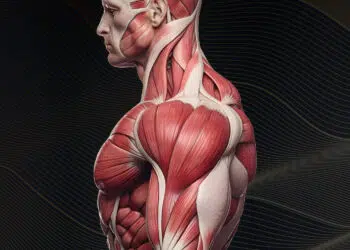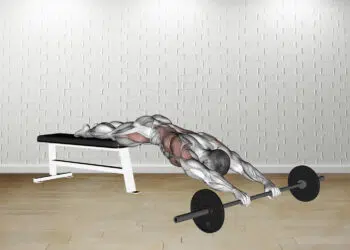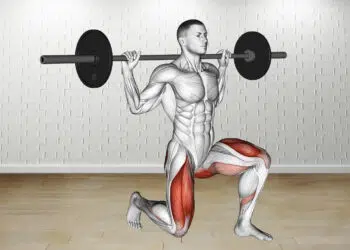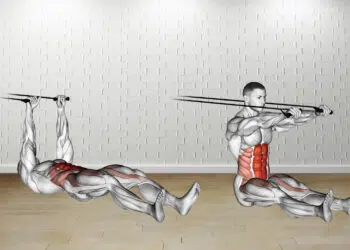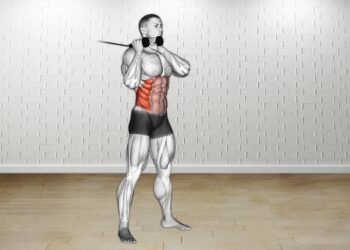The Svend press, also known as the pinch press, is a very effective exercise for building bigger and stronger pectoralis majors (chest). Although the Svend press is much different than conventional chest exercises, it’s still a great exercise to isolate the target muscles.
The Svend press is the namesake exercise of 2001 World’s Strongest Man winner Svend Karlsen. While the exercise might look easy, remember that it’s strongman-approved.
All you need for the exercise are two small weight plates. As weird as it might sound, the World’s Strongest Man invented an exercise that does not require anything more than a couple of 10-pound weight plates.
The Svend press involves squeezing the plates together in front of your chest, resulting in better pectoral muscle recruitment. So, include this exercise in your chest routine as a finisher, or do it as a standalone movement on your non-chest working days.
How to Do the Svend Press
This is how to perform the exercise:
- Stand upright with a shoulder-wide stance.
- Hold a 5 or 10-pound weight plate in each hand and press them against each other.
- Hold the weight plates in front and middle of your chest. The plates should be touching your chest, and your elbows slightly flared out at the starting position.
- While pressing the plates against each other as hard as you can, push the plates away from your body until your arms are straight out in front of you.
- Pause and contract your pecs at the top.
- Return to the starting position using a slow and controlled motion.
- Repeat for the desired number of reps.
Tips:
- Use weight plates that you can comfortably grip with your hands in a flat position.
- Make sure you’re pressing the weight plates against each other with all your might through the exercise for optimal pectoral engagement.
- Keep your torso erect and your chest up to maintain constant tension on your pecs.
- You should ensure that your arms are parallel to the floor throughout the exercise. Moving your arms at an angle will result in greater shoulder recruitment.
- Warming up your pecs before performing the Svend press will ensure better muscle recruitment and pumps.
- Pro tip: You could achieve better pectoral engagement during the exercise by pressing the plates against each other using your carpus (base of the hand) instead of the complete hand.
Muscles Worked
The Svend press primary targets your upper and lower pectoralis major. Establishing a mind-muscle connection and achieving a pump while performing the exercise might require some practice.
Level Up Your Fitness: Join our 💪 strong community in Fitness Volt Newsletter. Get daily inspiration, expert-backed workouts, nutrition tips, the latest in strength sports, and the support you need to reach your goals. Subscribe for free!
However, once dialed in, the Svend press could become your go-to exercise for annihilating your pecs at the end of your chest workouts.
Since the Svend press involves pushing the weight plates in front of your body, it will result in anterior deltoid and triceps engagement. Remember, if you feel tension on your biceps during the exercise, you’re probably going too heavy and should try again with a lighter weight.
Common Mistakes
Some of the most prevalent Svend press mistakes include:
Moving Too Fast
Many lifters treat the Svend press like the dumbbell press and rush through the movement. However, to make the most of the lift, you should slow down your rep tempo and focus on contracting your pecs throughout the range of motion.
If you feel you cannot complete the stipulated reps while following a slow rep speed, you should try dropping the weights you are using. Your form, more than anything else, plays the most important role in this exercise.
Moving Arms at an Angle
As mentioned above, to get the best bang for your buck in this exercise, you should ensure your arms are parallel to the floor throughout the movement.
Lowering your arms or lifting them above shoulder height will result in greater delt engagement. Forget that a WSM champ created this exercise and focus on exercise form precision rather than chasing bigger weights.
Slouching Your Shoulders
Rounding your back or slouching your shoulders while performing the exercise can take away tension from your chest and put it on your shoulders.
During the exercise, maintain an upright torso and keep your chest up and shoulders pinned back. Also, you shouldn’t be shrugging your shoulders while performing the Svend press.
Benefits of Svend Press
Advantages of adding the Svend press to your exercise arsenal include:
Less Taxing on the Joints
If you’ve ever performed the barbell or dumbbell bench press, you probably know these are high-impact exercises, meaning they put your shoulder and elbow joints under significant stress.
Plus, since your shoulder rotator cuffs are tiny muscle groups, they fatigue faster than your pecs, making you leave gains on the table.
On the other hand, the Svend press puts the majority of the focus on your pecs. Plus, since you won’t probably be lifting more than 20 to 30 pounds in this exercise, it reduces your chances of injury during training.
Level Up Your Fitness: Join our 💪 strong community in Fitness Volt Newsletter. Get daily inspiration, expert-backed workouts, nutrition tips, the latest in strength sports, and the support you need to reach your goals. Subscribe for free!
Plus, the Svend press is a great exercise for people recovering from an injury who cannot risk performing high-impact exercises like the bench or dumbbell press.
Better Pectoral Recruitment
Although the Svend press is a compound movement, it helps you focus on your target muscles by making you slow down and contracting your pecs with every rep.
If you want to build muscle mass, your goal should be to achieve muscular hypertrophy, which helps build muscle size and strength. With its low weight load and longer time under tension, the Svend press is designed for hypertrophy.
Improves Your Mind-Muscle Connection
If you struggle with achieving muscle pumps while training your chest, you should add the Svend press to your training regimen. Furthermore, the mind-muscle connection you establish during the Svend press will carry forward to other chest exercises.
A Great Finisher
If you are someone who loves leaving the gym with a nasty pump, the Svend press is the perfect fit for you. The exercise isn’t overly demanding and ensures maximal pectoral muscle fiber recruitment, resulting in muscle-ripping pumps.
Svend Press Variations and Alternatives
Here are Svend press variations and alternatives worth trying:
1. Dumbbell or Kettlebell Svend Press
If you train in your garage gym or basement and don’t have access to barbells or weights plates, you can perform the Svend press using a dumbbell or kettlebell.
To perform the variation, grab a dumbbell’s handle with both hands and follow the steps mentioned above. While using a kettlebell, grasp the cannonball using both hands.
For maximum pectoral engagement, you should squeeze the dumbbell’s handle as hard as possible and press against the cannonball using both hands with all your might.
2. Cable Svend Press
The cable Svend press is an easier variation and great for beginners. Here is how to perform the exercise with the correct form:
- Set cable pulleys at chest height and attach D-handle bars on each side.
- Grab a D-handle in each hand, and stand in the center of the pulley machine.
- Take a step forward and stand with a shoulder-wide stance. Bring your hands in front of your chest. In the starting position, hold the handles with a neutral (palms facing each other) grip and press your hands together.
- Press the cables forward by extending at your elbows.
- Pause and contract your pecs at the top.
- Slowly return to the starting position and repeat for reps.
- You could also perform this exercise lying on a bench, as demonstrated in the video above.
3. Incline Bench Svend Press
The upper chest is a weak muscle group for most people, and the incline bench Svend press is a great exercise to target your upper pecs.
- Set an incline bench at a 60-degree angle to the floor.
- Place your back against the inclined pad and plant your feet firmly on the floor.
- Hold a 5 or 10-pound weight plate in each hand and press them against each other.
- At the starting position, the weight plates should be right under your chin and above your upper pecs.
- Press the weight plates towards the ceiling while pressing the plates together.
- Pause and contract your chest at the top.
- Slowly return to the starting position and repeat for reps.
4. Hex Press
The Hex press is a dumbbell variation of the Svend press performed on a flat bench. Here is how to perform the exercise:
- Grab a dumbbell in each hand while sitting on the edge of a flat bench.
- Lay down and hold the dumbbells over your chest using a neutral grip — palms facing each other.
- Press the dumbbells against each other as hard as you can. Tuck your elbows into your sides. This will be your starting position.
- Push the weights up and over your chest until your arms are straight. Make sure you are actively pressing the dumbbells together throughout the exercise.
- Pause and contract your pecs at the top.
- Slowly lower the dumbbells to your chest.
- Repeat for recommended reps.
Check out our complete hex press guide!
5. Barbell Floor Press
Since the barbell floor press involves a limited range of motion and puts less tension on your rotator cuffs than the conventional bench press, it can be considered an alternative to the Svend press.
- Set up by placing a mat on the floor and loading up a barbell with an appropriate weight.
- Sit on the floor with the barbell on your thighs. Grasp the barbell with a wider than shoulder-width overhand grip and lay back on the floor while pushing the barbell to your chest.
- Alternatively, lay back on the floor and have a training partner pass you the barbell.
- Slowly lower the barbell until your upper arms are almost touching the floor.
- Press the bar towards the ceiling until your arms are fully extended.
- Slowly return to the starting position.
- Repeat for desired reps.
Check out our complete barbell floor press guide!
Wrapping Up
The Svend press is one of the most underutilized chest exercises. It is one of the lifts that look easy but will leave your pecs begging for mercy as soon as you begin the exercise.
Make sure you are contracting your pecs with every rep. The Svend press is a great exercise to pre-exhaust your pecs at the beginning of a workout or finish with a muscle-ripping pump.
Interested in measuring your progress? Check out our strength standards for Bench Press, Floor Press, Dumbbell Bench Press.



